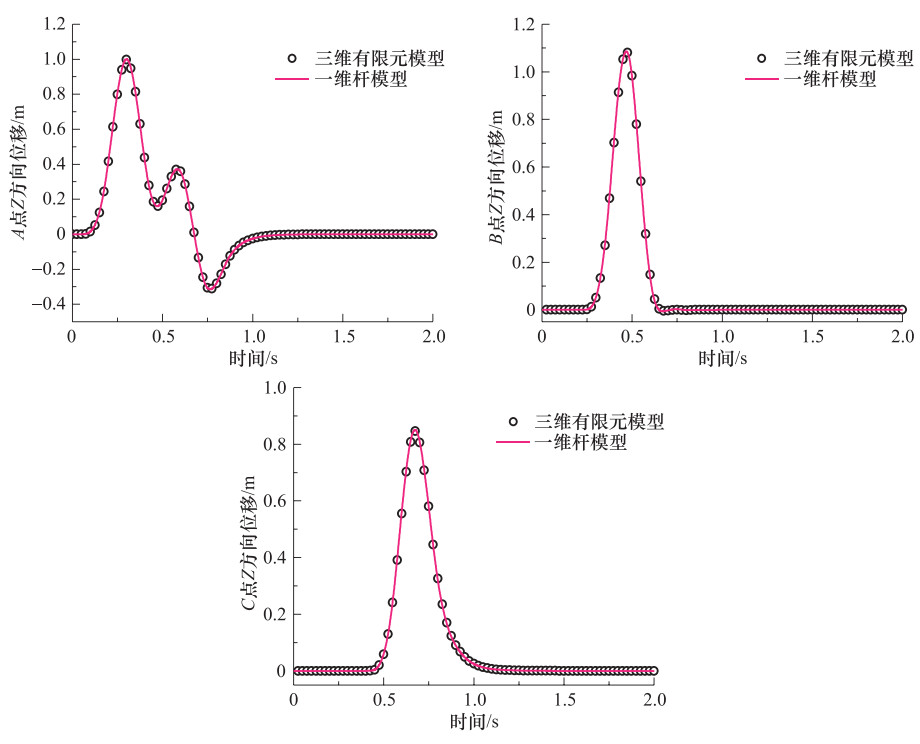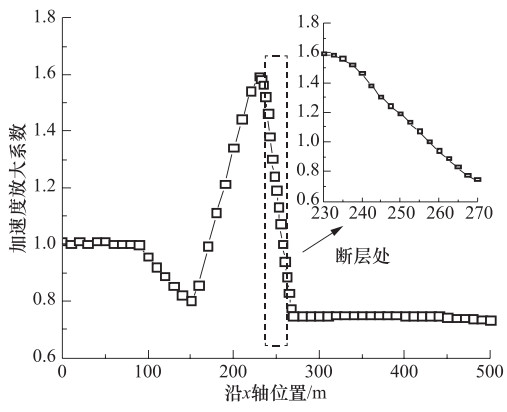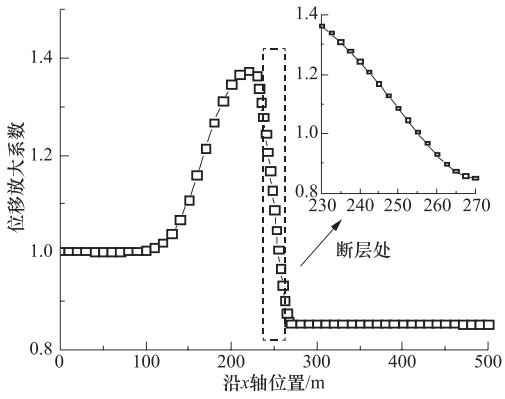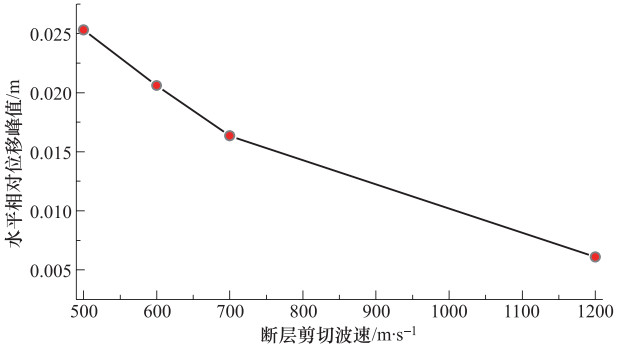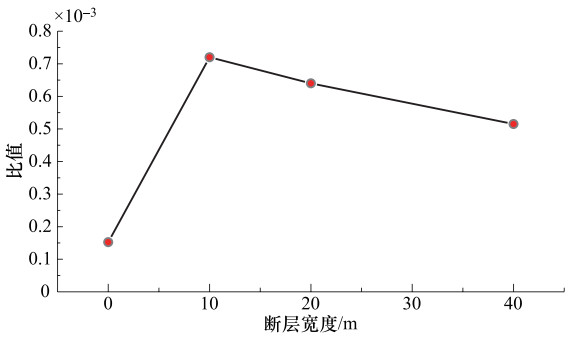Analysis of Dynamic Response of Rock Tunnels with Vertical Fault Fracture Zone under SH Waves
-
摘要: 结合黏弹性人工边界的时域波动输入方法和显式有限元法,设计了含垂直断层三维场地的SH波输入方法。基于建立的输入方法,研究了垂直断层对隧道地震响应的影响,并通过自由场算例验证了该方法具有较好精度。数值模拟结果表明:对于断层迎波侧的隧道结构,断层会对其地震动响应产生显著的放大作用,对于断层逆波侧的隧道结构,断层会对其产生隔离地震动的作用;相对周围围岩,断层介质的剪切波速越小,其产生的放大效应和隔震效果也会越显著;断层宽度越小,其对隧道地震动响应的影响范围也就越小,但是断层宽度的变化对于断层两侧隧道的地震动响应的影响并不明显。Abstract: On the basis of the time-domain wave method coupling the explicit finite element method with the viscous-spring artificial boundary condition, the input method of horizontal propagating SH waves for rock-vertical fault system is proposed in this study. The precision of the present approach is verified by a half space example. Subsequently, the proposed method is applied to investigate the long lined tunnels through vertical fault zone subjected to SH waves. The numerical results indicate that the dynamic response of tunnels on meeting waves side is amplified, whereas that on back waves sides is reduced. With increasing the shear wave velocity, the response of tunnels on meeting waves side decreases and that of the other side increases. The influence scope increases with increasing the width of fault. However, the amplitudes of tunnel's acceleration and stress do not have remarkable change.
-
表 1 围岩与断层材料参数
Table 1. Material parameters of fault and surrounding rock
材料 密度/kg·m-3 剪切波速/m·s-1 泊松比 围岩 2500 1200 0.3 断层 2000 400 0.36 表 2 模型材料参数
Table 2. Material parameters of model
材料 密度//kg·m-3 泊松比 弹性模量/GPa 粘聚力/MPa 内摩擦角/° 衬砌 2500 0.2 30 2.38 58.7 围岩 2500 0.3 9.36 表 3 断层介质参数
Table 3. Parameters of fault medium
断层 剪切波速/m·s-1 弹性模量/GPa 泊松比 密度//kg·m-3 第1组 500 1.4 0.4 2000 第2组 600 1.958 0.36 2000 第3组 700 2.857 0.325 2200 第4组 1200 9.36 0.3 2500 -
杜修力, 赵密, 王进廷, 2006.近场波动模拟的人工应力边界条件.力学学报, 38(1):49-56. http://d.old.wanfangdata.com.cn/Periodical/lxxb200601007 杜修力, 黄景琦, 赵密等, 2014.SV波斜入射对岩体隧道洞身段地震响应影响研究.岩土工程学报, 36(8):1400-1406. http://d.old.wanfangdata.com.cn/Periodical/ytgcxb201408006 何川, 李林, 张景等, 2014.隧道穿越断层破碎带震害机理研究.岩土工程学报, 36(3):427-434. http://d.old.wanfangdata.com.cn/Periodical/csjsllyj2015162228 李林, 何川, 耿萍等, 2012.隧道穿越高烈度地震区断层带围岩地震响应分析.重庆大学学报, 35(6):92-98. http://d.old.wanfangdata.com.cn/Periodical/cqdxxb201206015 刘晶波, 谷音, 杜义欣, 2006.一致粘弹性人工边界及粘弹性边界单元.岩土工程学报, 28(9):1070-1075. doi: 10.3321/j.issn:1000-4548.2006.09.004 潘旦光, 楼梦麟, 范立础, 2001.多点输入下大跨度结构地震反应分析研究现状.同济大学学报, 29(10):1213-1219. doi: 10.3321/j.issn:0253-374X.2001.10.016 王峥峥, 2009.跨断层隧道结构非线性地震损伤反应分析.成都: 西南交通大学. http://cdmd.cnki.com.cn/Article/CDMD-10613-2010115784.htm 张广洋, 李旭升, 高波等, 2011.行波激励下穿越断层隧道的地震响应分析.公路, (10):233-237. http://d.old.wanfangdata.com.cn/Periodical/gl201110053 Deeks A. J., Randolph M. F., 1994. Axisymmetric time-domain transmitting boundaries. Journal of Engineering Mechanics, 120(1):25-42. doi: 10.1061/(ASCE)0733-9399(1994)120:1(25) Liu J. B., Lu Y. D., 1998. A direct method for analysis of dynamic soil-structure interaction based on interface idea. Developments in Geotechnical Engineering, 83:261-276. doi: 10.1016/S0165-1250(98)80018-7 Lysmer J., Kuhlemeyer R. L., 1969. Finite dynamic model for infinite media. Journal of the Engineering Mechanics Division, 95(4):859-878. http://d.old.wanfangdata.com.cn/NSTLQK/NSTL_QKJJ026836908/ Shahidi A. R., Vafaeian M., 2005. Analysis of longitudinal profile of the tunnels in the active faulted zone and designing the flexible lining (for Koohrang-Ⅲ tunnel). Tunnelling and Underground Space Technology, 20(3):213-221. doi: 10.1016/j.tust.2004.08.003 Wang W. L., Wang T. T., Su J. J., et al., 2001. Assessment of damage in mountain tunnels due to the Taiwan Chi-Chi Earthquake. Tunnelling and Underground Space Technology, 16(3):133-150. doi: 10.1016/S0886-7798(01)00047-5 Wang Z. Z., Gao B., Jiang Y. J., et al., 2009. Investigation and assessment on mountain tunnels and geotechnical damage after the wenchuan earthquake. Science in China Series E:Technological Sciences, 52(2):546-558. doi: 10.1007/s11431-009-0054-z Yashiro K., Kojima Y., Shimizu M., 2007. Historical earthquake damage to tunnels in Japan and case studies of railway tunnels in the 2004 Niigataken-Chuetsu earthquake. Quarterly Report of RTRI, 48(3):136-141. doi: 10.2219/rtriqr.48.136 -




 下载:
下载:





